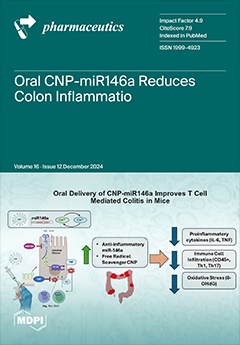Ver ítem
- xmlui.general.dspace_homeCentros e Institutos de InvestigaciónCIA. Centro de Investigaciones de AgroindustriaInstituto de Tecnología de AlimentosArtículos científicosxmlui.ArtifactBrowser.ItemViewer.trail
- Inicio
- Centros e Institutos de Investigación
- CIA. Centro de Investigaciones de Agroindustria
- Instituto de Tecnología de Alimentos
- Artículos científicos
- Ver ítem
Lipid Nanoparticle Formulations for the Skin Delivery of Cannabidiol
Resumen
Background/Objectives: The aims of this work were to formulate cannabidiol in different lipid carriers for skin delivery after topical application and to study their stability, interaction with the skin, and antibacterial activity. Methods: Solid lipid nanoparticles and nanostructured lipid carriers loaded with cannabidiol were prepared and characterized in terms of their physicochemical properties, colloidal stability, protection of the antioxidant
[ver mas...]
Background/Objectives: The aims of this work were to formulate cannabidiol in different lipid carriers for skin delivery after topical application and to study their stability, interaction with the skin, and antibacterial activity. Methods: Solid lipid nanoparticles and nanostructured lipid carriers loaded with cannabidiol were prepared and characterized in terms of their physicochemical properties, colloidal stability, protection of the antioxidant capacity of cannabidiol, as well as their retention over time. Skin penetration was assessed using an in vitro model with human skin. The antibacterial activity was tested against Staphylococcus aureus and compared to free cannabidiol. Results: Three nanoformulations exhibited the best size and reproducibility values and were selected for further studies. The formulations were stable, protected the active ingredient, succeeded in delivering it to deep skin layers, and demonstrated antibacterial activity. Conclusions: These cannabidiol nanoformulations show potential for use in skin diseases and conditions, as they protect the active ingredient, enhance its delivery to the skin, and exhibit antibacterial effects.
//Resumen:
Antecedentes/Objetivos: Los objetivos de este trabajo fueron formular cannabidiol en diferentes portadores lipídicos para administración cutánea después de la aplicación tópica y estudiar su estabilidad, interacción con la piel y actividad antibacteriana. Métodos: Se prepararon nanopartículas lipídicas sólidas y portadores lipídicos nanoestructurados cargados con cannabidiol y se caracterizaron en términos de sus propiedades fisicoquímicas, estabilidad coloidal, protección de la capacidad antioxidante del cannabidiol, así como su retención en el tiempo. La penetración en la piel se evaluó utilizando un modelo in vitro con piel humana. La actividad antibacteriana se probó contra Staphylococcus aureus y se comparó con el cannabidiol libre. Resultados: Tres nanoformulaciones exhibieron los mejores valores de tamaño y reproducibilidad y fueron seleccionadas para estudios adicionales. Las formulaciones fueron estables, protegieron el ingrediente activo, lograron llevarlo a las capas profundas de la piel y demostraron actividad antibacteriana. Conclusiones: Estas nanoformulaciones de cannabidiol muestran potencial para su uso en enfermedades y afecciones de la piel, ya que protegen el ingrediente activo, mejoran su entrega a la piel y exhiben efectos antibacterianos.
[Cerrar]

Autor
Calienni, Maria Natalia;
Scavone, Mirian Ana;
Sanguinetti, Ana Paula;
Corleto, Merlina;
Di Meglio, Magalí Rocío;
Raies, Pablo;
Cristos, Diego Sebastian;
Maffia, Paulo César;
Montanari, Jorge;
Fuente
Journals Pharmaceutics 16 (12): 1490. (2024).
Fecha
2024-12
Editorial
MDPI
ISSN
1999-4923
Formato
pdf
Tipo de documento
artículo
Palabras Claves
Derechos de acceso
Abierto
 Excepto donde se diga explicitamente, este item se publica bajo la siguiente descripción: Creative Commons Attribution-NonCommercial-ShareAlike 2.5 Unported (CC BY-NC-SA 2.5)
Excepto donde se diga explicitamente, este item se publica bajo la siguiente descripción: Creative Commons Attribution-NonCommercial-ShareAlike 2.5 Unported (CC BY-NC-SA 2.5)


